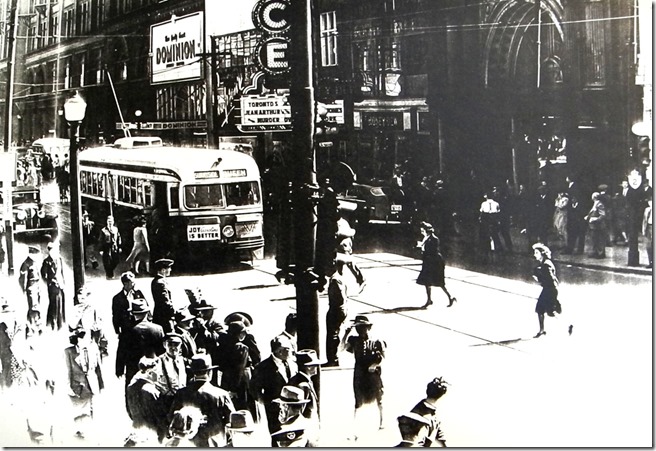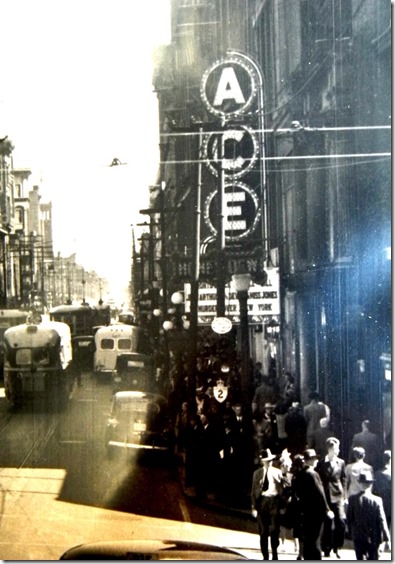The above photo gazes at the south side of Queen Street West, where the Ace Theatre was located. The view looks east toward Yonge Street. The Simpsons Store, now the Bay, is in the top left-hand corner of the photo. The photo from the City of Toronto Archives was taken September 6, 1941, although there is a 1930s auto on the north side of the street.
The Ace Theatre was originally named the Photodrome, which opened in 1915. Its name was derived from an apparatus “consisting of a large wheel with spokes, which when turning very rapidly is illuminated by momentary flashes of light passing through slits in a rotating disk. By properly timing the succession of flashes the wheel is made to appear to be motionless, or to rotate more or less slowly in either direction.” (Source: Free Dictionary online.)
The theatre was one of Toronto’s early-day movie theatres. It possessed a stage, so likely featured vaudeville as well as silent movies. It was located at 39 Queen West, to the east of Bay Street. Unlike the Colonial (Bay) Theatre, two doors to the west, the Photodrome was not located in a structure that was purposely constructed for it, but was on the ground floor of a four-storey office building. The theatre possessed a large rectangular canopy that extended out over the sidewalk.
When it opened, the First World War was raging in Europe and silent movies were well attended since they provided an escape from the horrifying news from the front lines. It remained a popular theatre after the World War One and this continued into the 1920s. After sound films were introduced in the late-1920s, the theatre was converted to accommodate them. This assured its popularity during the Great Depression.
In 1935, Sam Ulster purchased the Photodrome Theatre. In 1941, the son of Sam Ulster, Ben Ulster, renovated the theatre and reopened it on September 1 of that year as the Ace Theatre. It contained approximately 360 seats, about the same capacity as when it had been the Photodrome. For the opening, it offered a midnight show, a novel idea in this decade. Ben Ulster also owned the Broadway on Queen Street and Rio Theatre on Yonge Street. The Ulster family owned of the Town and Country Restaurant on Mutual Street. I remember this eatery very well as it was famous for its buffet, which featured roast beef and lobster. Its main rival was the Savarin Tavern on Bay Street. In 1942, the lobby of the Ace Theatre featured a display of sandbags and weapons to draw attention to the war effort and to encourage the purchase of War Bonds. The Ace Theatre was a familiar sight for many Torontonians as its huge sign, containing the letters A,C and E, were huge, each of them surrounded by large circles.
Similar to the Bay Theatre (the former Colonial), the Ace was sold to Simpson’s. The large sign for the Ace, which had sparkled nightly on Queen Street for many years, was sold to Nat Taylor’s 20th Century theatre chain, about the year 1947. It was installed on the former Regal (Iola) Theatre at 605 Danforth Avenue, which then became the Ace, but it had no connection with the theatre on Queen Street other than the sign.
Note: I am grateful to Mildred Ulster, the wife of Ben Ulster, for supplying information for this post.
This 1918 photo shows the Photodrome Theatre at 39 Queen West. It is on the left-hand side of the photo, with the large rectangular canopy extending out over the sidewalk. To the right (west) of it is the Colonial (Bay) Theatre, at 45 Queen West. The view gazes east along the south side of Queen Street, toward Yonge. Simpsons (now the Bay) is to the east of the Photodrome.
This undated sketch from the Toronto Archives depicts the interior of the Photodrome Theatre. It reveals that there was a stage and that the washrooms were in the basement.
The Ace Theatre in the 1940s.
Gazing east on Queen Street West toward Yonge Street, from the intersection of Bay and Queen on September 6, 1941.This photo from the City of Toronto Archives (G&M 13893) was taken at the height of the Second World War. In the right-hand bottom corner of the photo is a delivery truck of the Toronto Telegram newspaper.
To view the Home Page for this blog: https://tayloronhistory.com/
To view previous posts about other movie houses of Toronto—old and new
https://tayloronhistory.com/2013/10/09/links-to-toronto-old-movie-housestayloronhistory-com/
To view links to other posts placed on this blog about the history of Toronto and its heritage buildings:
https://tayloronhistory.com/2013/10/08/links-to-historic-architecture-of-torontotayloronhistory-com/
Recent publication entitled “Toronto’s Theatres and the Golden Age of the Silver Screen,” by the author of this blog. The publication explores 50 of Toronto’s old theatres and contains over 80 archival photographs of the facades, marquees and interiors of the theatres. It also relates anecdotes and stories from those who experienced these grand old movie houses.
To place an order for this book:

![1918sequeenandbaygk6[1] 1918sequeenandbaygk6[1]](https://tayloronhistory.files.wordpress.com/2014/08/1918sequeenandbaygk61_thumb.jpg)



![cid_E474E4F9-11FC-42C9-AAAD-1B66D852[2] cid_E474E4F9-11FC-42C9-AAAD-1B66D852[2]](https://tayloronhistory.files.wordpress.com/2014/08/cid_e474e4f9-11fc-42c9-aaad-1b66d8522_thumb3.jpg)


Hi Doug, the very first photo you post here, that you note the date decision… it was taken by the **same** person I suspect – and the **same** day – as the one you note as dated 1941. Note the “torpedo back” car that’s in the first – same car in the second. And the shadows are the same (same time of day), AND the marquis on the theater has the same **movie** listed. 🙂 Hope that helps. And thanks for this. I’m working on dating a photo of my grandmother and father who were out, in Toronto, in front of Bowle’s Lunch, and it would appear likely to be this street, a little further west, at Bay St. (though I have found a weird discrepancy – “FE Luke Optician” appears overhead as a sign, and that was on Yonge St. – a block away??) Anyway, working on my mystery and this helped!